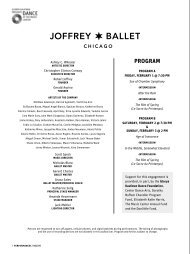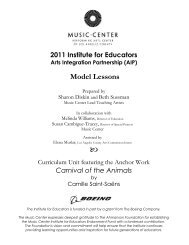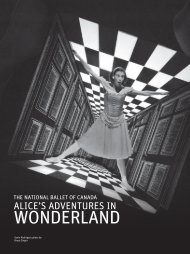Selected Poems of Joy Harjo - Music Center
Selected Poems of Joy Harjo - Music Center
Selected Poems of Joy Harjo - Music Center
You also want an ePaper? Increase the reach of your titles
YUMPU automatically turns print PDFs into web optimized ePapers that Google loves.
Step-by-Step Sequence <strong>of</strong> Learning - use these cognitive processes: experience, inquiry, creation, performance, reflection, assessment<br />
Model Lesson Four – Puppetry Arts: Design a Shadow Puppet<br />
Prior to the Lesson: Teachers guide student groups in deciding who will make the puppets for each line in the Found Poem. Students are familiar with the<br />
line <strong>of</strong> poetry that will be the basis for their puppet design. Teachers share video clips <strong>of</strong> shadow puppetry with students.<br />
ASSESS PRIOR KNOWLEDGE<br />
What are some examples <strong>of</strong> Shadow Puppetry that you have seen?<br />
What is unique or special that you can you do or show with shadow puppets?<br />
What are the dreamlike, imaginative qualities in Shadow Puppetry?<br />
EXPERIENCE - Getting Smarter<br />
Introduction:<br />
Present historical/cultural context for Shadow Puppetry. (Refer to handout)<br />
Show examples <strong>of</strong> shadow puppets from different cultures.<br />
Demonstrate a sample <strong>of</strong> shadow puppets.<br />
Lesson Instructions:<br />
“In this lesson we will practice techniques to create different visual effects. Each <strong>of</strong> you will choose an image from your group’s Found Poem as an<br />
inspiration for your puppet design. We will work in this lesson and the following lesson to design and complete your shadow puppet.”<br />
Let’s look at some <strong>of</strong> the design elements that the puppeteer used to create a shadow puppet. Teacher shares examples <strong>of</strong> these elements on the screen to<br />
connect elemental concepts with visuals demonstrated on the Shadow Screen.<br />
o Shape: Observe how this triangle and oval come together to form a fish. Combinations <strong>of</strong> shapes give the puppets meaning.<br />
o Shapes are important to shadow puppetry, because we will not see drawn details or much color, but we will find the meaning from the outlines <strong>of</strong> the<br />
shapes, which we will see as a shadow.<br />
o Silhouette: Observe how Teacher draws a simple face on the paper. Can you see it on the screen? When you are designing for shadow puppets, you<br />
need to consider the silhouette, the outer contours <strong>of</strong> the shape.<br />
Let’s see an example <strong>of</strong> a face that is a silhouette. We see the shape through what is cut out and what remains for you to see as a shadow on the<br />
screen.<br />
o Positive space is the filled-in or solid space. Negative space is the empty space between, inside and around the shapes.<br />
Artists who make paper cuts help us see shape.<br />
o Teacher shares sample paper cuts from China, Mexico and the artist, Henri Matisse.<br />
Now we will make a series <strong>of</strong> three paper cuts to practice making various shapes.<br />
For each shape we will first talk about the shape and see examples. Next, I will demonstrate a practice cut and then you will make a cut.<br />
<strong>Music</strong> <strong>Center</strong> Anchor Work Model Curriculum Unit: <strong>Selected</strong> <strong>Poems</strong> <strong>of</strong> <strong>Joy</strong> <strong>Harjo</strong>.<br />
©2011 <strong>Music</strong> <strong>Center</strong>: Performing Arts <strong>Center</strong> <strong>of</strong> Los Angeles County. All Rights Reserved.<br />
14






